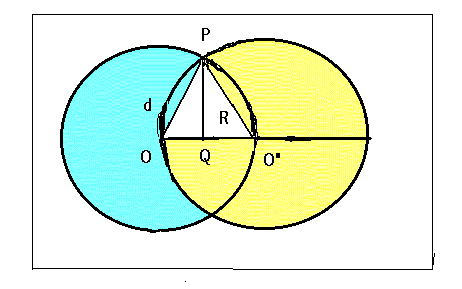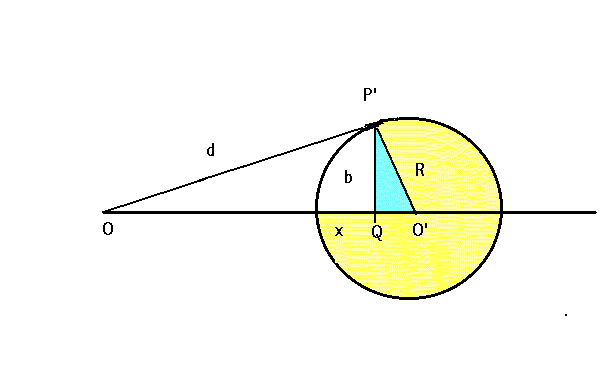ANSWER FOR DRUNKEN WALK
(PUZZLE-2)
As we have explained in the hint we can go step by step.
STEP:1 Let us assume that the drunkard starts
his walk from the origin ‘O'. After the step 1 is taken he will be anywhere
on the perimeter of the circle with center as ‘O’ and the radius as ‘R’.
STEP:2 Now he can take his second step from
anywhere on the perimeter of the above circle. Let us take one such point on
the horizontal axis say ‘O’’; his second step from this chosen point O’
can take him to any point on the perimeter of the second circle with center
as O’ and radius as R. Please look at the “Diagram I”
Diagram 1

When the second step is taken from the point O’ he
can be at any point ‘P’ on the circle with O’ as the center and R
as radius. The distance from the lamp post will be OP (d) which
can be found by using the Pythagoras theorem.
[Looking at the above diagram, OP=d ; OO’ = O’P = R ;
b is the vertical distance from P to line OO’ dividing the
line into two parts of lengths ‘x’ and ‘R-x ‘respectively.]
Now we can write, d2 = x2 + b2
= x2 + R2-
( R – x )2(Taking the value of 'b' from triangle PQO')
= x2 + R2- R2 - x2 + 2 Rx
= 2Rx
Since ‘x’ varies from 0 to 2R with
equal probability the average expected value is R. ( We can consider the
point P to lie in the lower half of the circle also with exactly the
same results.)
Hence d2 = 2 R2 or d = √2 R.
Thus for one point on the circle after the first step , he will
be at a point effectively at a distance √2 R from the origin after step
2. If we consider every point in the circle after the first step, he would be
at any point in the perimeter of a circle with O’ as the center and the radius
as √2 R after step 2.
STEP:3 Now when the drunkard takes the third
step, he will be doing it from the center O’ which is √2R
from the origin and again with a radius
R. Let us again look at one of the possible places he may land up-‘P’’
and we can once again estimate the distance of such a point from O by
using again the Pythagoras theorem. Please look at Diagram 2.
Diagram 2

OP' = d ; OO’ = √2R ; O’P' = R ; the vertical
distance from P' to line OO’ is b and it cuts into two portions of lengths
x(=XQ) and R – x (=QO') respectively.
OP’2 = d 2= OQ2 + b2
=({√2R} – {R-x })2
+ ( R2 – { R-x}2) as OQ=(OO'-QO')
Using the same argument as before:- i.e., since x varies
from 0 to 2R with equal probability for all the points in the
semi circle above ( as well as below ) the expected value of x is R.
Hence substituting for the same, we will get the above
equation now as,
OP’2= d 2 = (√2R)2
+ ( R ) 2
= 2 R2 + R 2
= 3 R 2
Hence, d =
√3 R. Thus if we consider all the points of the circle with center √2R
from O we will now have a circle with the diameter √ 3R with
center O as the effective distance after the third step. Now a look at
the diagram as well as the above equation will make you realize that for every
additional step the expected distance increases by square root of one more
number after the earlier number. Hence after N steps he can be expected
to be at a distance √N R from the origin.

BACK TO HOME PAGE